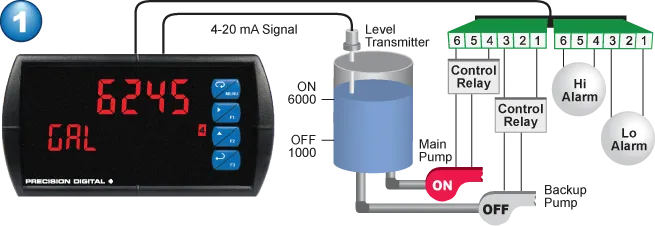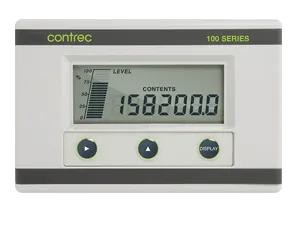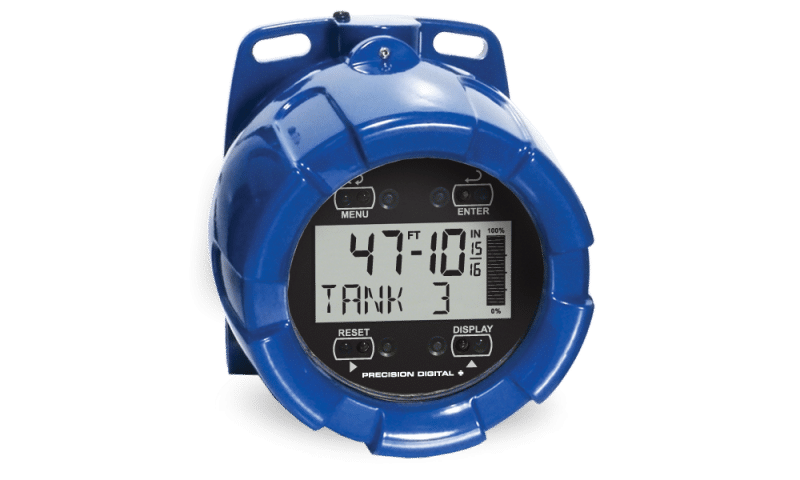Level is one of the most commonly measured process parameters in a wide range of applications and industries. Available level transmitters range from mechanical floats and contact probes to radar and ultrasonic sensors. Whatever the type, these transmitters are almost commonly difficult and dangerous to access. Even if a display is included, the small built‐in displays are difficult to read once installed. Including a remote level display showing easy to understand engineering units in a convenient location is a critical step in developing a level measurement solution.
Considering the following five topics will help you create a safe, effective, and efficient level measurement system. Including the right level display to accompany a level transmitter can have a dramatic impact.
1. Stop Stumbling Over Pipes, Climbing Up Tanks and to Flooded Tank Farm!!
The use of a separate level display for a transmitter is crucial because it reduces safety risks and improves the likelihood of critical problems being spotted early, hence improving efficiency.
Enhanced operator safety is one of the most important reasons to include a remote display for level transmitters. Level transmitters often located on the top of tanks and silos are notoriously hazardous to read. OSHA acknowledges the danger this poses with the heavy regulation of ladders and stairs used to access these high locations. Even round horizontal tanks, wells, sump pits, and other ground‐level transmitter locations often require navigating a dangerous maze of pipes and cables or reading a transmitter display mounted at ground level. A remote display, mounted where operators can easily access it, eliminates these safety risks.
A separate display also increases the chance of process problems being spotted early, before it develops into a critical problem. The tank level is being measured for a reason, and it is often critical the level be controlled and monitored. An easy to read, bright, and conveniently mounted display will be seen more often by operators, alerting them to any process changes.
Besides the safety aspects, a remote display can minimize the time operators spend climbing up tanks and stumbling over pipes and sometimes to a flooded tank farm due to pump failure.
2. Display what meaningful
Many level transmitters that include displays default to a 0-100 percent display scale. This may not be meaningful for operators. Consider what information is most useful to your operators, and pick a meter that can display it. The information displayed from a 4-20 mA level transmitter signal includes 0-100%, height (in meters, etc.), volume, and empty volume.
Once you know what information the operators should have or wants, pick a meter with a display that accommodates that kind of information. Some meter options that can impact your display choice are discussed below.
Dual-Line: a dual-line display is great for applications that require either a programmable unit for the measurement (i.e., PCT, Water, Tank 2, Well 5) or where two readings would be desirable. Some meters, such as the PD6000 from Precision Digital, allow a single 4‐20 mA signal to be scaled two ways so that a single meter can display percent full and height, or height and volume.
Volume: Operators interested in the content of the tank rather than just 0-100%. So the volume in the tank means a lot to operators. The contents are displayed for the maximum contents of the tank.
Large Display: In many applications, large displays visible from a distance are the most convenient option. These can be valuable for specific installations, from panel meters with 1.2-inch displays to large field enclosures with 2+ inch digits.
3. Mount to right position
A useful level display must be located somewhere convenient to access by the operator. Ideally, it will also be easy to install. Consider what type of mounting would work best for your installation.
Panel Meter: Panel meters, often in 1/8 DIN cutouts, are an easy way to mount a remote level display near other controls that operators regularly use in control panels or instrument enclosures used by other equipment. They are also the right choice when you want to group multiple displays close together, as one enclosure can house many panel meters. These meters require a control panel or enclosure with a cutout to be fully sealed, and that panel or enclosure will need its own mounting method and installation location.
Field Mount Meter: If the level display is the only piece of user control equipment installed in the area, a field mount meter combines accessible front controls and a fully sealed enclosure into one display. The display is integrated into a full enclosure that protects the internal electronics without a cabinet, control panel, or other enclosure for protection. They are usually pipe or wall-mounted, though some may be mounted directly to metal conduit.
Wall/Pipe Mount: The panel meter enclosure or field mount device is usually wall or pipe mounted. A wall mount meter will be bolted right to a flat surface. A pipe mount meter will install with a u‐bolt strapping it onto a pipe. Consider your installation site and make sure you have the appropriate hardware to mount the meter you choose in the operator’s best location. Many meters will have accessories or kits to make a wall or pipe mounting easier. Don’t choose the mounting location based on what is convenient for the hardware you happen to have on hand, or the display may end up in a difficult location to see.
Hazardous Locations: Hazardous locations require special approved equipment, such as FM, CSA, ATEX, or IECE approvals. They involve many specialized installation requirements, but the basics of considering your mounting location in advance still apply. Most modern explosion-proof meter enclosures include wall and pipe mounting options, and some are light enough for direct conduit mounting. Intrinsically safe meters are often panel or field mount meters.
4. Power conveniently
Tanks, silos, sumps, wells, and other typical level measurement sites are often isolated. Running power to these locations can be costly and time-consuming. Consider what power source your remote level display will use based on what power may already be available. This will reduce time, cost, and aggravation when installing a remote display.
High Voltage/Line Power: The most common power supply for level display, high voltage power is usually in the range of 85-265 VAC or VDC.
Low Voltage: Low voltage displays that function in the 9-36 VDC or VAC range are available for most remote displays. Many isolated installation sites have access to this type of voltage supply as it is used on many transmitters and control devices.
4-20 mA Loop-Powered: 4-20 mA loop-powered devices draw their power from the 4-20 mA loop that is provided from the transmitter. This is ideal for installations where running low voltage to the transmitter is easy, as the remote display then only needs two wires. Loop-powered meters do not have access to output options like relays and retransmitting analog outputs, so their use is limited to reasonably simple level indication applications.
5. More than a Level Display
While it is vital to utilize a remote display to put critical level information where operators need it, level meters and controllers can do more than display the level transmitter signal. Consider what other features your remote display has and how they can be used to simplify your installation by being the heart of your local level control system.
Alarm Monitors: Most remote displays are available with relays or open collector outputs that allow them to operate as high and low alarms. These alarms can control large indication LEDs, stacked alarm lighting, or audible alarms. Open collector outputs allow loop‐powered and intrinsically safe products to alarm and control a similar way to relay on the safe area or explosion-proof meters.
Pump Controllers: Some meters like Precision Digital’s PD6000 and PD8-6000 panel meters can be used to replace traditional pump controllers. With the level display and LED interface for programming, these are easier to use and offer more control than traditional pump controllers while offering the same lead-lag and pump alternation features used in multi-pump level control systems.

Multivariable Modbus® Level Displays: New Modbus level meters allow a single transmitter to monitor the top material level and interface level and temperatures. Modbus level meters can be used to have a single meter display all of these critical variables in settling tanks.



